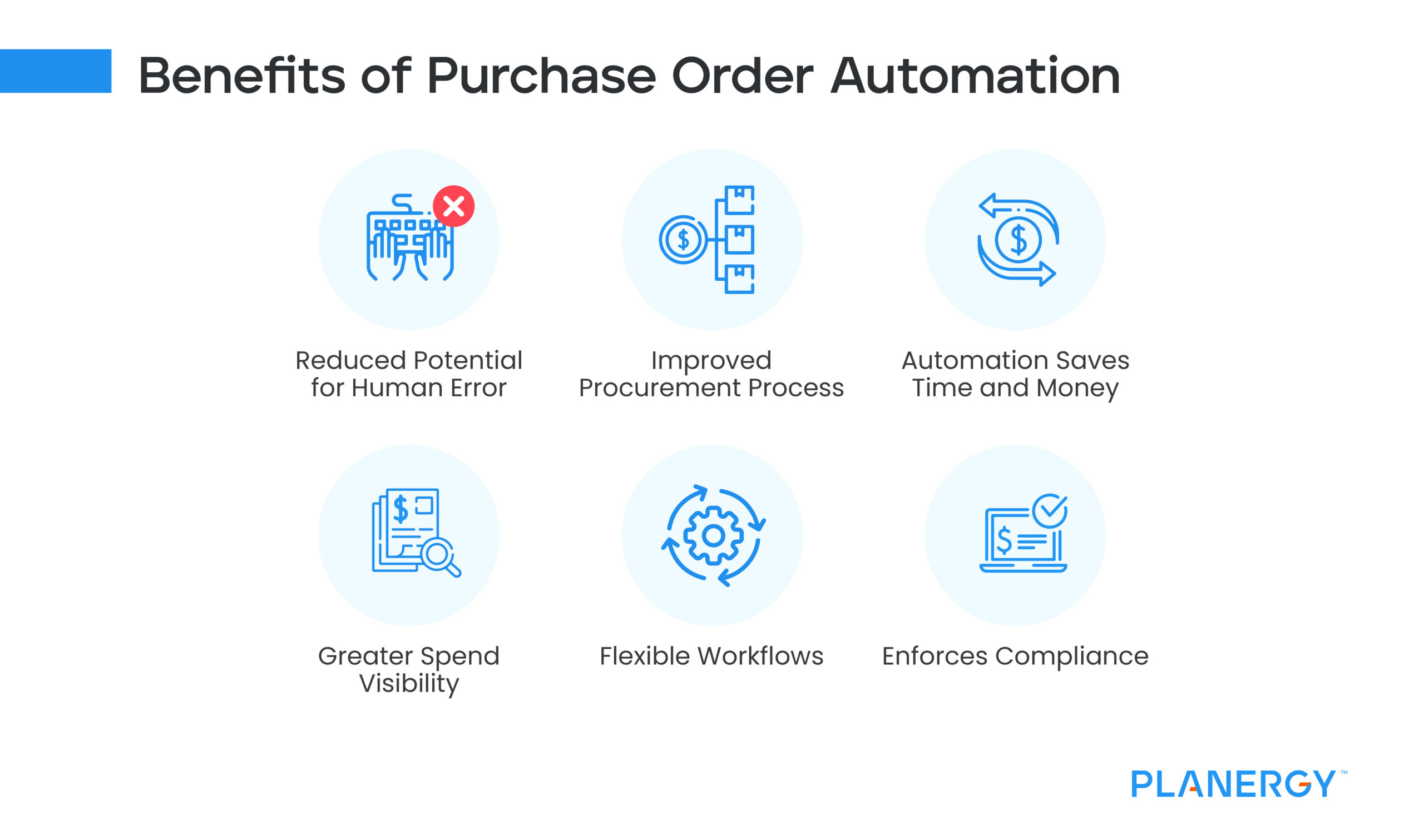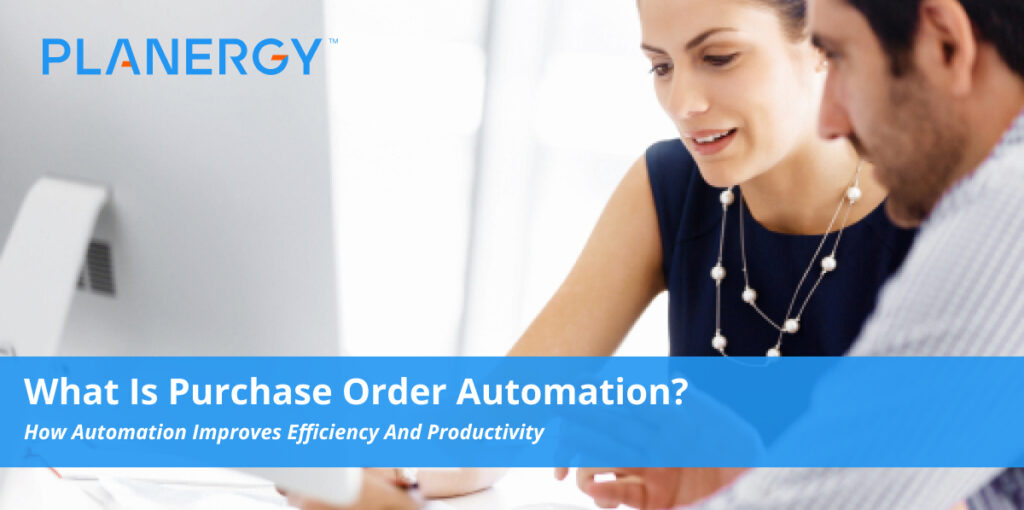Purchase order automation means using software to digitize purchase orders and automate the purchase order process to reduce manual steps.
This involves automatically sending purchase requisitions out for approval, automating approval workflows, then once approved, automatically sending the PO to the vendor.
It replaces the need for traditional paper purchase orders and tracking purchase orders using excel, and streamlines purchase order workflows. It will also enforce any purchase order policy you put in place.
Handling orders manually is time-consuming and error-prone and can create an avalanche of problems within your organization: paper goes missing, duplicate orders get processed, and approvals take too long.
The purpose of purchase order automation is to solve these problems by reducing the amount of time and labor needed for the purchase order process.
Automating the purchase order process also makes things easier for suppliers. When they get the automated PO, suppliers can quickly convert that to an accurate invoice. This makes it easier for your accounts payable (AP) department to manage the payments.
Purchase order automation software can add an additional layer of protection for your business through automated three-way matching.
This process helps to automate accounts payable by automatically checking POs, invoices, and receipts/packing slips to ensure you’re only receiving ordered items and only paying for the goods and services received.
If there’s a mistake where goods and services were not received—or the wrong product was shipped—the issue is quickly spotted so the AP team doesn’t blindly pay invoices or leave invoices sitting too long.
Whether you’re sending purchase orders or receiving them, automating the purchase order system can help manage everything more effectively, reduce work, and reduce costs.
How Do You Automate the Purchase Order Process?
Automating the purchasing process will involve implementing purchase order software and moving your processes from paper and Excel into it. Then, you’ll set up automation for all of your existing processes and start to save time.
The steps to go from a manual to an automated purchase order process look like this:
Identify a Suitable Software
Consider your requirements and research the best software to cover your current and future needs. PLANERGY is a flexible and customizable software built to scale with you. It can be used to automate the purchase order process but also covers the full Procure-to-Pay process.
Integrate With Financial Systems
The first step is to map your integrated ERP and/or accounting system to the purchase order software to ensure all the required information is available. The software provider should offer support to ensure you get up and running quickly with the required data for your custom needs.
Define Policy and Approval Workflows
In addition to mapping fields from integrated systems, you’ll also want to define your purchase order policy and set up the purchase order approval process so that requisitions can be approved and automatically turned into POs, which are then automatically sent to suppliers.
Different approval workflows may be needed for different departments as well as at different monetary thresholds.
Implement Automation
Once the information you need is in the system and approval flows are set up, it’s time to automate purchase orders. Your purchase order software will enable your team to set up an automated flow where users can create a requisition, route that requisition to the required approvers, turn that requisition into a PO, then email that PO to your preferred supplier.
Ideally, this can be done from anywhere at any time over a cloud-based app, giving you more flexibility and faster approval times.

What Are the Benefits of Purchase Order Automation?
Moving from manual processes or outdated systems to purchase order automation comes with multiple benefits.
While large businesses have clear benefits from making this switch due to their large scale, even small businesses will eventually outgrow the old way of processing purchase orders and benefit as well.
Automation can reduce the time required to complete the PO cycle by half
(Graphic idea: Visual representation of the purchase order benefits listed here, with the heading ‘Benefits of Purchase Order Automation’)
Key benefits of purchase order automation include:
Reduced Potential for Human Error
Purchase orders are binding legal contracts between a buyer and a seller. They must indicate the types, quantities, and agreed-upon pricing for products and services. Internally, they are used to control purchasing and to keep an eye on departmental budgets and overall cash flow.
Mistakes on the PO lead to back and forth between the vendor and the buyer to get things right. This leaves organizations spending more money than intended, tying up cash with incorrect orders, or even slowing down production.
Manual purchase order management creates a higher potential for errors, which then must be tracked down and addressed.
Errors include incorrect supplier names and codes, lack of authorization, failure to place orders with preferred suppliers, illegible handwriting, and failure to complete all required information.
Automated systems have the functionality to send an alert if information like supplier codes or names are missing, automate approval workflows to ensure proper authorization, and flag when non-preferred suppliers are requested—all of which reduce human error.
Improved Procurement Process
An automated purchase order system enables team members to set user permissions for approval routing, data entry for each supplier (uploading contracts, adding products and services to the catalog, payment terms, etc.), and more. Once setup is complete, it becomes easy to streamline the procurement process.
Business rules and approval templates can be set up to streamline the purchase order process. These rules can enforce who can:
- Submit purchase requests for their department
- Approve requisitions and convert them to purchase orders
- See and process invoices
- Make budget changes
They can also set which requisitions need approval, and by who. All of this is captured by an audit trail in case it’s needed for review.
For example, you can set a rule that any purchase under $50 is automatically approved. For higher-value purchases, you can set approvers for each department and send them automatic alerts when there is a requisition to approve. Once that’s approved, it can automatically become a PO and get emailed to the vendor.
Automation Saves Time and Money
Paper or Excel-based purchase order processing is time-consuming and has higher labor costs than automated purchase order processing.
With an automation solution, all the information needed to place an order is ready to go, automated approval flows are in place, and requisitions can turn into POs quickly.
Along with reducing repetitive tasks, automation can reduce the time required to complete the PO cycle by half, according to the American Productivity and Quality Center (APQC)’s Open Standards Benchmarking.
Rather than being printed, scanned, faxed, or mailed, these processes happen in real-time. Approvers are alerted instantly and POs are sent to suppliers right away. Documents spend no time sitting on people’s desks and less time getting processed. It’s also easier to track down records and past actions in the case of an audit.
When PO processing moves faster, it frees up significant time and money for procurement teams to focus on other business processes that create more value.
Greater Spend Visibility
Reporting features provide visibility into each department’s spending. This visibility enables you to secure better deals with your existing vendors and helps you figure out if you should find new vendors to work with.
Along with measuring supplier performance, you’ll have a better pulse on how the entire supply chain is performing. Purchase order software also enables you to search through all documents in the system and view the status of orders, invoices, and payments at any time—providing complete visibility over your procurement process.
Flexible Workflows
Purchasing automation software provides the flexibility to configure the system to meet your needs, whatever they may be. It makes it possible to restrict purchasing to certain dollar thresholds, suppliers, or specific items. Or, you can create blanket POs and automatically route them for approval.
The software will be flexible enough to meet your needs even for unique purchasing situations.
Enforces Compliance
Purchase order automation software has the added benefit of also automating the purchase policies and internal controls for purchasing a company sets in place. Policies such as the approval matrix, lists of approved suppliers, and required audit trails are programmed into the system for automatic, unbreakable compliance.
When people try to ‘go rogue’ and purchase without proper approval or from a non-preferred supplier, they won’t be able to. Even then, everything is recorded in an audit trail and can be recalled for compliance audits at any time.
This can also help companies automatically enforce other policies such as ESG (environmental, social, and corporate governance). If it is part of a company’s ESG goal to only purchase supplies from companies that don’t excessively pollute or exploit foreign workers, that can be baked into the purchase order software and automatically enforced.

Purchase Order Automation Makes Your Organization Better
Purchase order automation provides many benefits, including increased productivity, better compliance with corporate policy and contract terms, increased visibility into company spend, and more.
When using the platform to gain a deeper understanding of your buying patterns, you can locate strategic cost savings opportunities that provide a significant competitive advantage.
Organizing purchasing is essential to keeping maverick spending at bay and maximizing working capital. As your business grows, keeping track of company spend becomes critical to effective operations—and purchase order automation can become a key driver of value for your company.




